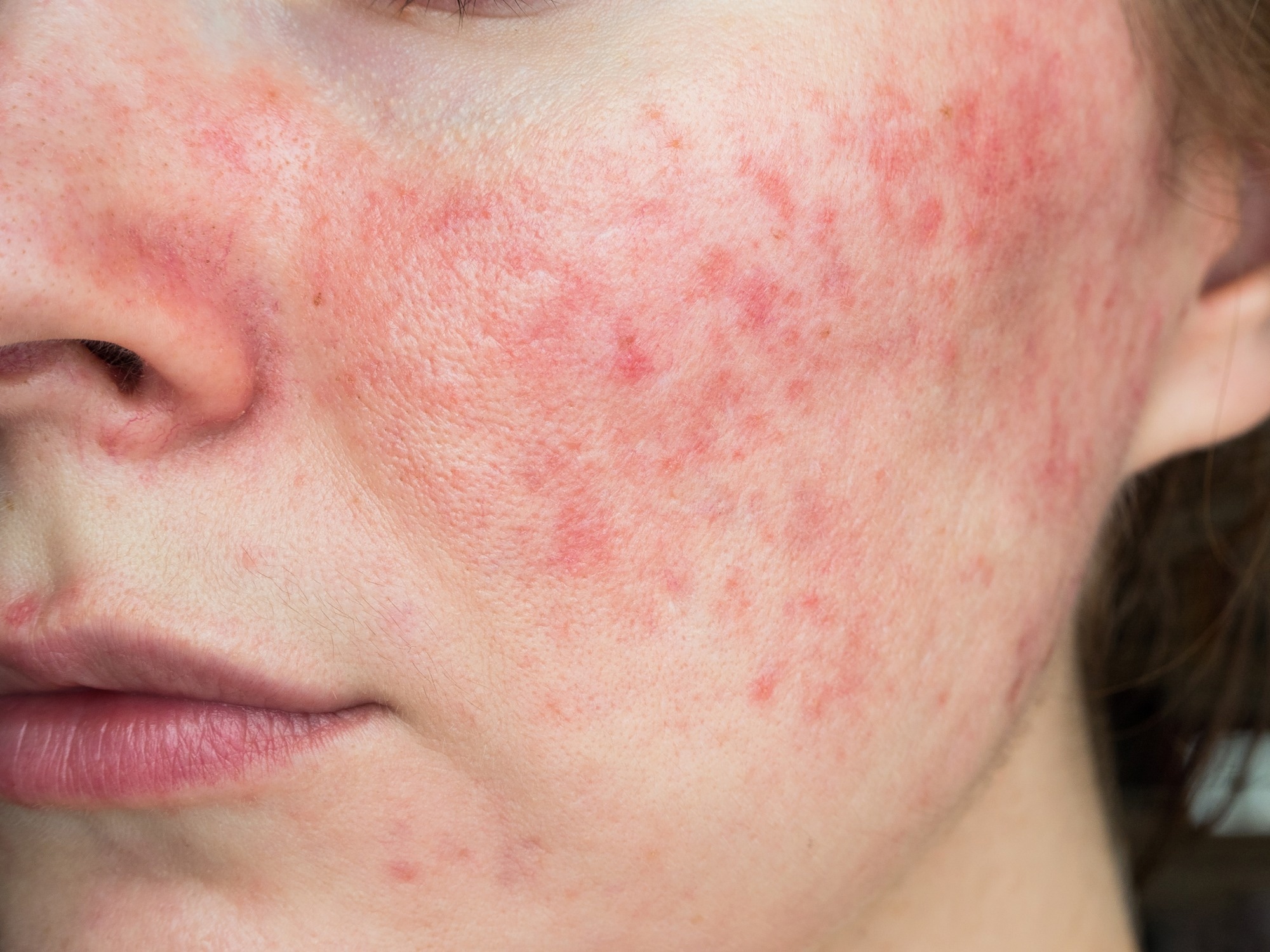In a recent review published in Pharmaceuticals, researchers reviewed existing data on rosacea management using botanicals.
 Study: Recent Advances in the Management of Rosacea through Natural Compounds. Image Credit: Julia Shauerman/Shutterstock.com
Study: Recent Advances in the Management of Rosacea through Natural Compounds. Image Credit: Julia Shauerman/Shutterstock.com
Background
Rosacea, a chronic dermatological disorder, is a subject of ongoing research. A third of affected individuals report developing depression and becoming less adherent to treatment.
The pathogenesis is controversial, and most medications have adverse effects or may not attain the desired results.
Dermatological products containing natural compounds are becoming increasingly popular due to their varied benefits and reduced side effects. Combining medicated treatments with natural products is recommended, as botanical extracts offer more tolerable side effects.
About the review
In the present review, researchers described the potential of phytochemicals in alleviating rosacea symptomatology based on data obtained from the PubMed, MDPI, Google Scholar, and Springer databases between February 2023 and September 2023.
An introduction to Rosacea
Rosacea, characterized by chronic skin inflammation, affects facial convexities, primarily affecting women in their midlife. Ethnicity influences rosacea development, and fair skin is the most affected.
Primary features include flushing, papules, pustules, telangiectasia, and ocular manifestations. Secondary features include burning or stinging, rough and scaly skin, edema, and phymatous changes.
Clinical subtypes include erythemato-telangiectatic (ETR), papulopustular (subtype II), phymatous (subtype III), and ocular (subtype IV).
Current data indicates that immune response alteration, genetic factors, oxidative stress, vascular dysfunctions, neurogenic inflammation, and Helicobacter pylori and Demodex infections can cause rosacea.
Various topical and oral therapies are available, such as metronidazole, azelaic acid, doxycycline, and ivermectin, but many have side effects, leading patients to drop treatment before its benefits manifest.
Active components of plants and their properties in managing rosacea
Botanicals have been utilized for centuries in skincare for wound healing and anti-aging, offering alternative options for doctors and patients with side effects from standard medications. Plant extracts contain chemical compounds essential for managing rosacea.
Plants have beneficial properties that address at least one of the factors responsible for triggering rosacea.
These properties include anti-microbial (Aloe vera L.), anti-angiogenic (Wormwood, Artemisia lavandulaefolia L., Chamomile, and Green Tea); protection against ultraviolet light (UV)-induced damage (Colloidal Oat, Feverfew, Green Tea, and Coffea arabica L.); anti-erythematous (Licorice, Indian Chrysanthemum, Bitter Wood, Feverfew, Tormentil, and Green Tea); and antioxidant (Licorice, Colloidal Oat, Feverfew, Tormentil., Green Tea, Yuzu Citrus Fruit, Coffeeberry, and Aloe vera L.).
Licorice root, Indian chrysanthemum flower, and Avena sativa contain various active components, including saponins, flavanones, chalcones, isoflavones, flavonols, chlorogenic acids, volatile oils, steroids, triterpenes, bitter principles, phenolic acids, alkaloids, unsaturated fatty acids, β-glucan, steroids, triterpenes, bitter principles, volatile oils, flavones, sesquiterpenes, terpenes, flavones, chlorogenic acids, flavones, and volatile oils. Chamomile flowers and Camellia sinensis L. leaves also contain flavonols, catechins, and polysaccharides.
Previous studies on natural compounds for rosacea management
A study showed that G. glabra leaf extract has high antioxidant and anti-inflammatory properties, making it a potential skincare ingredient for rosacea-affected skin.
The extract, including licoflavone, decreased inducible nitric oxide synthase (iNOS) and cyclooxygenase 2 (COX2) expression, making it an excellent treatment option for atopic dermatitis. A 2.0% licorice topical gel application for two weeks significantly reduced erythema, edema, and itching scores.
In a study, licochalcone A, derived from Glycyrrhiza inflata L., improved mean erythema and quality-of-life scores at four and eight weeks.
Colloidal oat lotions have anti-inflammatory and antipruritic properties that help lower skin dryness and trans-epithelial electrical resistance (TEER) by 52% compared to untreated tissue. Quassia amara extract showed improvement in most participants, significantly affecting telangiectasia.
Feverfew inhibited 5-lipoxygenase and cyclooxygenase, resulting in a reduction in platelet aggregation. Parthenolides, in particular, inhibited serotonin release from platelets. Artemisinin has anti-angiogenic and anti-inflammatory effects, which aid in treating rosacea.
In vivo studies have shown that P. erecta methanolic extract has antioxidant, antimicrobial, and wound-healing properties. Green tea extracts can absorb UV radiation and thus are particularly useful in treating rosacea.
Caffeine can inhibit oxidative stress-related senescence and underlying mechanisms. Recent studies have highlighted the antioxidant effects exerted by coffee extracts and reported photosensitive skin, former smoking habits, and family history as the primary risk factors for rosacea.
Conclusion
Overall, the review findings highlight the growing use of herbal products for treating rosacea, a complex condition with numerous questions concerning its pathophysiology.
Plant-based cosmetic preparations, including active botanical extracts and phytocompounds, hold promise in managing erythema and papules. However, the antiangiogenic mechanism is underreported.
The findings provide a comprehensive understanding of active botanicals and open new avenues for research on natural compounds in rosacea management.
Further research on rosacea management using botanicals could facilitate the development of pharmaceuticals that reduce off-target effects and enhance treatment efficacy and patient compliance.